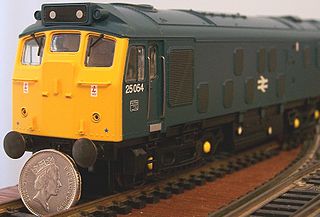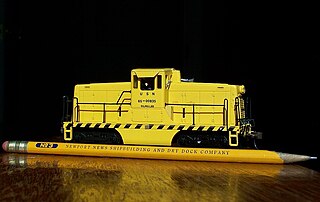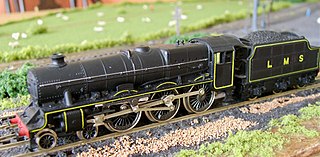Related Research Articles

Railway modelling or model railroading is a hobby in which rail transport systems are modelled at a reduced scale.

LGB stands for Lehmann Gross Bahn - the "Lehmann Big Train" in German. Made by Ernst Paul Lehmann Patentwerk in Nuremberg, Germany, since 1968 and by Märklin since 2007, it is the most popular garden railway model in Europe, although there are also many models of U.S. and Canadian prototypes. LGB caused a revival of garden model railroading in the United States when it was introduced. LGB is sold in North America through Wm. K. Walthers, who took over from Ernst Paul Lehmann's subsidiary, LGB of America, when Märklin bought the LGB assets. Most of the European prototypes were manufactured in Germany, while much of the North American rolling stock was made in China. Production was later moved to Hungary.

OO gauge or OO scale is the most popular standard-gauge model railway standard in the United Kingdom, outside of which it is virtually unknown. OO gauge is one of several 4 mm-scale standards, and the only one to be marketed by major manufacturers. The OO track gauge of 16.5 mm corresponds to prototypical gauge of 4 ft 1+1⁄2 in, rather than 4 ft 8+1⁄2 in standard gauge. However, since the 1960s, other gauges in the same scale have arisen—18.2 mm (EM) and 18.83 mm (Scalefour)—to reflect the desire of some modellers for greater scale accuracy.

The National Model Railroad Association (NMRA) is a non-profit organization for those involved in the hobby or business of model railroading. It was founded in the United States in 1935, and is also active in Canada, Australia, the United Kingdom, and the Netherlands. It was previously headquartered in Indianapolis, Indiana, and was based in Chattanooga, Tennessee next to the Tennessee Valley Railroad Museum (TVRM) from 1982 to 2013 and has since relocated to Soddy Daisy.

O scale is a scale commonly used for toy trains and rail transport modelling. Introduced by German toy manufacturer Märklin around 1900, by the 1930s three-rail alternating current O gauge was the most common model railroad scale in the United States and remained so until the early 1960s. In Europe, its popularity declined before World War II due to the introduction of smaller scales.

Whyte notation is a classification method for steam locomotives, and some internal combustion locomotives and electric locomotives, by wheel arrangement. It was devised by Frederick Methvan Whyte, and came into use in the early twentieth century following a December 1900 editorial in American Engineer and Railroad Journal.

HO or H0 is a rail transport modelling scale using a 1:87 scale. It is the most popular scale of model railway in the world. The rails are spaced 16.5 mm (0.650 in) apart for modelling 1,435 mm standard gauge tracks and trains in HO.

N scale is a popular model railway scale. Depending upon the manufacturer, the scale ranges from 1:148 to 1:160. In all cases, the gauge is 9 mm or 0.354 in. The term N gauge refers to the track dimensions, but in the United Kingdom in particular British N gauge refers to a 1:148 scale with 1:160 track gauge modelling. The terms N scale and N gauge are often inaccurately used interchangeably, as scale is defined as ratio or proportion of the model, and gauge only as a distance between rails. The scale 1:148 defines the rail-to-rail gauge equal to 9 mm exactly, so when calculating the rail or track use 1:160 and for engines and car wheel base use 1:148.

2mm scale, often 2mm finescale is a specification used for railway modelling, largely for modelling British railway prototypes. It uses a scale of 2 mm on the model to 1-foot on the prototype, which scales out to 1:152. The track gauge used to represent prototype standard gauge is 9.42 mm. Track and wheels are closer to dead scale replicas than commercial British N.
Protofour or P4 is a set of standards for model railways allowing construction of models to a scale of 4 mm to 1 foot (1:76.2), the predominant scale of model railways of the British prototype. For historical reasons almost all manufacturers of British prototype models use 00 gauge. There are several finescale standards which have been developed to enable more accurate models than 00, and P4 is the most accurate in common use.

4 mm scale is the most popular model railway scale used in the United Kingdom. The term refers to the use of 4 millimeters on the model equating to a distance of 1 foot on the prototype (1:76.2). It is also used for military modelling.

High rail is a phrase used in model railroading in North America, mostly in O scale and S scale, to describe a "compromise" form of modelling that strives for realism while accepting the compromises in scale associated with toy train equipment. The phrase exists due to the observation that traditional Lionel and American Flyer toy train track sits much higher than finescale track.

The Gorre & Daphetid model railroad was a notable HO scale layout built by John Whitby Allen in Monterey, California.
John H. Armstrong was a mechanical engineer, inventor, editor, prolific author, and model railroader best known for layout design and operations. He was married for 44 years to Ellen Palmer. They had four children.

Rail transport modelling uses a variety of scales to ensure scale models look correct when placed next to each other. Model railway scales are standardized worldwide by many organizations and hobbyist groups. Some of the scales are recognized globally, while others are less widespread and, in many cases, virtually unknown outside their circle of origin. Scales may be expressed as a numeric ratio or as letters defined in rail transport modelling standards The majority of commercial model railway equipment manufacturers base their offerings on Normen Europäischer Modellbahnen (NEM) or National Model Railroad Association (NMRA) standards in most popular scales.
The EMD DH1 was an experimental diesel-hydraulic switching locomotive built by General Motors Electro-Motive Division in May 1906. It was powered by a pair of small diesel engines suspended under the frame, driving through a pair of Allison torque converter transmissions to the inside wheels on each truck. These inside wheels were substantially smaller than the outside wheels on each truck. One example exists in Clinton, Michigan as of 20020.
J. Anthony Koester, more commonly known as Tony Koester, is a well-known member of the United States model railroading community. Koester popularized the idea of proto-freelancing with his HO scale model railroad layout, the Allegheny Midland, along with his friend Allen McClelland's Virginian & Ohio. Koester is an alumnus of Purdue University where he studied electrical engineering. While at Purdue, he was also a member of the Model Railroad Club. In 1966, he helped co-found the Nickel Plate Historical & Technical Society to preserve the memory of his favorite railroad.

British N gauge is a model railway scale and gauge, rolling stock is to a scale of 1:148, track is 9 mm width as with all other N gauges making track and rolling stock approximately 10% out of scale with respect to each other. The 9 mm track width derives from a scale of 1:160 for 1,435 mmstandard gauge rails.
Finescale standards or Fine Standards are model railway standards that aim to be close to the prototype dimensions. Reduction in toylike, overscale flanges, pointwork, etc. In Britain it is particularly used because small British prototypes meant that track gauge is underscale. Modelling to finescale standards requires skill, so modellers usually start with the coarse standards applied to ready-to-run models suitable as toys. Standards are set by modellers' societies.
References
- ↑ http://www.proto87.org
- ↑ http://www.proto87.org/p87/standards/standards.gif [ dead link ]
- ↑ Coleman, Matt (2008). The Model Railroader's Guide to Logging Railroads. Kalmbach Publishing, Co. p. 76. ISBN 978-0-89024-702-0.
- ↑ Volhard, Jim (1999). Maintaining and Repairing Your Scale Model Trains. Kalmbach Publishing, Co. p. 44. ISBN 978-0-89024-324-4.